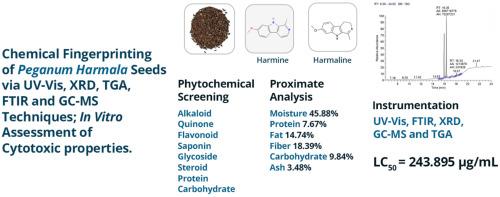UV-Vis、XRD、TGA、FTIR、GC-MS等化学指纹图谱研究体外细胞毒性评价。
IF 2.4
4区 医学
Q2 PHARMACOLOGY & PHARMACY
引用次数: 0
摘要
作为一种多年生草本植物,对其化学成分和细胞毒性进行了分析。甲醇种子提取物含有多种初级和次级代谢物,包括生物碱、类黄酮、皂苷、糖苷、类固醇、蛋白质和碳水化合物。近端分析显示高水分(45.88%)和粗纤维(18.39%),中等脂肪(14.74%)和蛋白质(7.67%)含量。光谱研究支持β-碳碱生物碱的存在:FTIR光谱显示出特征性的官能团振动,UV-Vis在440 nm处显示出强吸收,x射线衍射显示出富含毒芹碱和毒芹碱的半结晶模式。气相色谱-质谱法鉴定出主要成分为毒芹碱(53.13%)和毒芹碱(39.12%)。热分析(热重-差热分析和热重分析)表明多相分解是复杂有机基质的典型特征。MTT法对L929成纤维细胞的细胞毒性评估显示,细胞活力呈剂量依赖性下降,LC50为243.9 μ mL-1,具有中高的细胞毒性潜力。这些发现证实了缬草的民族医学意义,并强调了其在植物医学、营养保健应用和药物研究方面的前景,同时强调了标准化和规范使用以确保疗效和安全性的必要性。本文章由计算机程序翻译,如有差异,请以英文原文为准。

Chemical fingerprinting of Peganum harmala seeds via UV–Vis, XRD, TGA, FTIR, and GC-MS techniques; In vitro assessment of cytotoxic properties
Peganum harmala L., a perennial herb traditionally valued for medicinal and ritual uses, was comprehensively profiled to elucidate its chemical composition and cytotoxic potential. Methanolic seed extracts contained diverse primary and secondary metabolites, including alkaloids, flavonoids, saponins, glycosides, steroids, proteins, and carbohydrates. Proximate analysis revealed high moisture (45.88 %) and crude fibre (18.39 %) with moderate fat (14.74 %) and protein (7.67 %) levels. Spectroscopic studies supported the presence of β-carboline alkaloids: FTIR spectra showed characteristic functional group vibrations, UV–Vis displayed a strong absorption at 440 nm, and X-ray diffraction revealed semi-crystalline patterns enriched in harmine and harmaline. GC–MS provided definitive chemical identification, detecting harmine (53.13 %) and harmaline (39.12 %) as major constituents. Thermal analyses (TGA–DTA and DTG) indicated multiphase decomposition typical of complex organic matrices. Cytotoxicity assessment using the MTT assay on L929 fibroblast cells demonstrated a dose-dependent decline in cell viability, with an LC50 of 243.9 μg/mL, signifying moderate–high cytotoxic potential. These findings validate the ethnomedicinal significance of P. harmala and underscore its promise for phytomedicine, nutraceutical applications, and pharmaceutical research, while highlighting the necessity of standardized and regulated use to ensure efficacy and safety.
求助全文
通过发布文献求助,成功后即可免费获取论文全文。
去求助
来源期刊

Toxicon
医学-毒理学
CiteScore
4.80
自引率
10.70%
发文量
358
审稿时长
68 days
期刊介绍:
Toxicon has an open access mirror Toxicon: X, sharing the same aims and scope, editorial team, submission system and rigorous peer review. An introductory offer Toxicon: X - full waiver of the Open Access fee.
Toxicon''s "aims and scope" are to publish:
-articles containing the results of original research on problems related to toxins derived from animals, plants and microorganisms
-papers on novel findings related to the chemical, pharmacological, toxicological, and immunological properties of natural toxins
-molecular biological studies of toxins and other genes from poisonous and venomous organisms that advance understanding of the role or function of toxins
-clinical observations on poisoning and envenoming where a new therapeutic principle has been proposed or a decidedly superior clinical result has been obtained.
-material on the use of toxins as tools in studying biological processes and material on subjects related to venom and antivenom problems.
-articles on the translational application of toxins, for example as drugs and insecticides
-epidemiological studies on envenoming or poisoning, so long as they highlight a previously unrecognised medical problem or provide insight into the prevention or medical treatment of envenoming or poisoning. Retrospective surveys of hospital records, especially those lacking species identification, will not be considered for publication. Properly designed prospective community-based surveys are strongly encouraged.
-articles describing well-known activities of venoms, such as antibacterial, anticancer, and analgesic activities of arachnid venoms, without any attempt to define the mechanism of action or purify the active component, will not be considered for publication in Toxicon.
-review articles on problems related to toxinology.
To encourage the exchange of ideas, sections of the journal may be devoted to Short Communications, Letters to the Editor and activities of the affiliated societies.
 求助内容:
求助内容: 应助结果提醒方式:
应助结果提醒方式:


